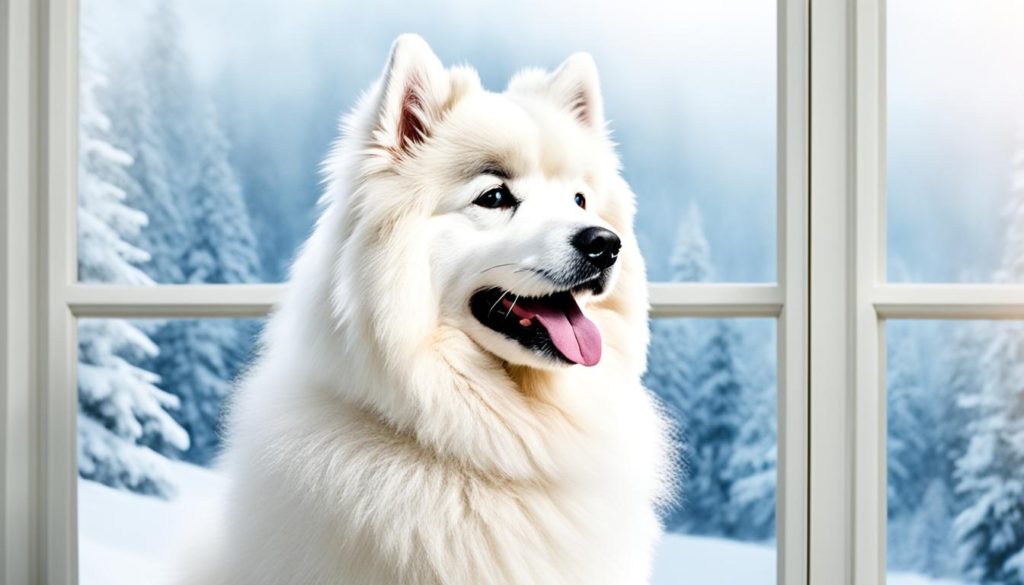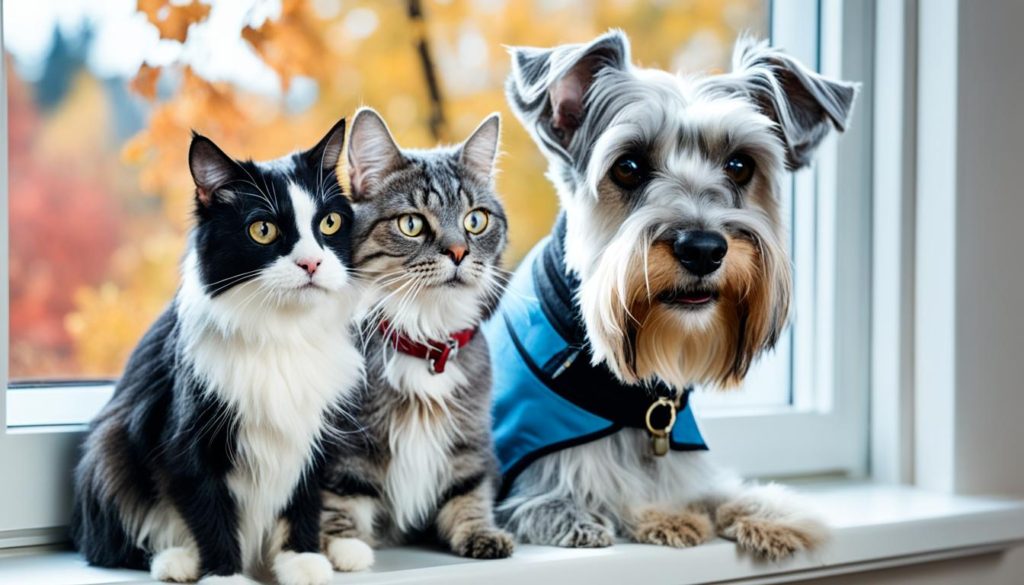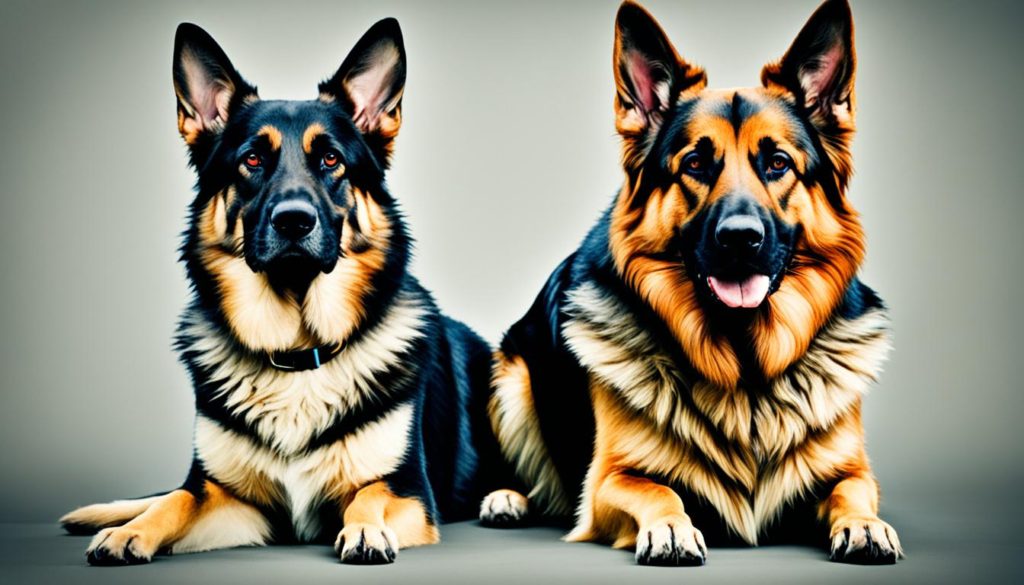If you have a cat at home, you know that cats and dogs don’t always get along. To ensure a harmonious living environment for all of your pets, it’s crucial to choose the right dog breed. Some dog breeds have characteristics that make them incompatible with cats, and being aware of these breeds is essential.
Not all dog breeds have a natural affinity for cats. Certain breeds are more aggressive towards cats, while others may have a strong hunting instinct that can pose a threat to your feline companion. By understanding which dog breeds to avoid if you have cats, you can prevent any potential conflicts and ensure a peaceful coexistence between your pets.
Key Takeaways:
- Not all dog breeds are suitable for households with cats.
- Some dog breeds may be aggressive towards cats.
- Certain breeds have a strong hunting instinct that can pose a threat to cats.
- Choosing the right breed is crucial for a peaceful coexistence between dogs and cats.
- Understanding which breeds to avoid can help prevent potential conflicts.
Scottish Deerhound
If you have a cat in your home, it’s essential to choose a dog breed that is compatible with feline companions. However, the Scottish Deerhound, a hunting breed, may not be the best choice for households with cats. This breed’s natural instincts as a hunter can pose a danger to cats and other small animals.
The Scottish Deerhound is a large and athletic breed that was originally developed for hunting deer in the Scottish Highlands. Their keen sense of sight and speed make them excellent hunters, but it also means that they may view cats as prey.
As a hunting breed, Scottish Deerhounds possess an innate instinct to chase and pursue smaller animals, including cats. This natural prey drive can put your feline companion at risk if they are not properly introduced and supervised. It’s important to remember that even well-trained Scottish Deerhounds may find it challenging to suppress their hunting instincts when faced with a cat.
To ensure the safety and well-being of your cat, it is crucial to take extra precautions when considering adding a Scottish Deerhound to your household. Here are some steps you can take:
- Slow and supervised introductions: When introducing a Scottish Deerhound to your cat, take it slow and ensure close supervision. Start by keeping them in separate areas of the house and gradually allow them to interact under controlled circumstances.
- Training and socialization: Early and consistent training is key to teaching your Scottish Deerhound appropriate behavior around cats. Positive reinforcement techniques can help redirect their prey drive and establish boundaries.
- Providing safe spaces: Create separate spaces for your cat and Scottish Deerhound where they can retreat and feel safe. This can help minimize potential conflicts and provide your cat with a sense of security.
Remember, each dog is an individual, and while breed tendencies can guide our expectations, there are always exceptions. However, it’s important to be aware of the inherent risks associated with the Scottish Deerhound’s hunting instincts when considering adding one to a household with cats.
Samoyed
The Samoyed is a stunning and friendly dog breed known for its fluffy white coat and cheerful personality. However, it’s important to be aware that Samoyeds were historically bred for hunting purposes, making them a part of the hunting breed category.
While Samoyeds can be trained to coexist peacefully with cats, it’s essential to understand that their inherent instinct to chase and potentially harm small animals may still be present. This instinct can sometimes pose a challenge when introducing them to feline companions in the household.
Training and Socialization
To ensure a harmonious relationship between Samoyeds and cats, proper training and socialization are crucial. Training should focus on teaching the Samoyed to view cats as friends rather than prey. Early socialization with cats can help familiarize the Samoyed with their presence and reduce the likelihood of aggressive behavior.
Positive reinforcement techniques, such as rewarding good behavior and redirecting attention away from chasing or aggressive behavior, can be effective in training Samoyeds to get along with cats. Consistency and patience are key in this process.
“Training a Samoyed to peacefully coexist with cats requires patience, consistency, and positive reinforcement. With the right approach, it is possible to build a safe and harmonious environment for both pets.” – Dr. Maria Hernandez, Animal Behavior Specialist
Tips for Introducing Samoyeds to Cats
When introducing a Samoyed to a household with cats, it’s important to take gradual steps and provide a controlled environment. Here are some tips to help ensure a successful introduction:
- Keep the Samoyed on a leash during the initial encounters to have better control over their movements.
- Start introductions in a neutral territory, such as a separate room or a fenced yard.
- Supervise the interactions between the Samoyed and the cats, rewarding positive behavior and intervening when necessary.
- Allow the cats to retreat to their safe spaces if they feel uncomfortable or overwhelmed.

By following these guidelines and investing time in training and socialization, it is possible to foster a peaceful coexistence between Samoyeds and cats. However, it’s important to individualize the approach based on each pet’s unique personality and needs.
Shih Tzu
When it comes to dog breeds that may not get along with cats, the Shih Tzu is an intriguing case. Unlike some other breeds on this list, the Shih Tzu is a small dog breed, which may not pose a direct threat to cats due to size alone. However, it’s important to be aware that Shih Tzus can exhibit jealousy towards other pets, including cats, especially when it comes to receiving attention from their human companions.
This jealousy can lead to animosity and tension between Shih Tzus and cats, potentially creating an uncomfortable living environment for both pets. It’s crucial to ensure that both the Shih Tzu and the cat receive equal amounts of attention, affection, and care to minimize jealousy-induced conflicts.
To promote a harmonious relationship between your Shih Tzu and cat, consider implementing the following tips:
- Establish a routine where both pets receive individual attention and quality time with you.
- Provide separate spaces for each pet to retreat to when they need some time alone.
- Introduce positive reinforcement training techniques to encourage good behavior and prevent jealousy-driven aggression.
- Supervise interactions between the Shih Tzu and cat, especially during the initial stages of their relationship.
- Ensure that both pets have their own resources, such as food bowls, water bowls, and litter boxes, to avoid competition.
By taking these preventive measures and consistently addressing any signs of jealousy or aggression, you can increase the chances of a peaceful coexistence between your Shih Tzu and cat. Remember, patience, consistency, and proper socialization are key to fostering a positive relationship between these two pets.
Schnauzer
When it comes to potential conflicts between dogs and cats, even small breeds like the Schnauzer can pose a challenge. Schnauzers are known to be high-strung dogs, and their energetic nature can easily stress out a cat. If you have a Schnauzer and a cat in the same household, it’s essential to understand how to manage their interactions to create a harmonious environment.
Early socialization plays a crucial role in ensuring that your Schnauzer develops positive behaviors and learns to coexist with your cat. Introducing them to each other at a young age can help familiarize them, reducing the chances of aggressive or anxious behavior towards each other. Slow and controlled introductions, supervised interactions, and positive reinforcement can enhance their relationship and minimize stress on your cat.
However, it’s important to note that even with early socialization, Schnauzers have a natural inclination for chasing small animals. This chasing behavior can trigger stress in cats and potentially result in conflicts. Therefore, it’s crucial to provide your cat with safe spaces where they can retreat and feel secure when needed, such as cat trees, shelves, or separate rooms.
In conclusion, early socialization is key to helping your Schnauzer and cat coexist. By introducing them at a young age and providing a controlled environment, you can minimize the stress on your cat and foster a more harmonious relationship between the two. Remember to always monitor their interactions and prioritize their safety and well-being.
Tips for Managing Schnauzer and Cat Interactions:
- Start introductions slowly, gradually increasing their time together.
- Supervise their interactions to prevent any aggressive behavior.
- Reward positive interactions with treats and praise.
- Provide your cat with safe spaces to retreat to when feeling overwhelmed.
- Consider using baby gates or separate play areas to create boundaries.
Quotes:
“Proper early socialization is vital in helping Schnauzers and cats build a harmonious relationship.”
– Pet Behavior Expert, Dr. Emma Roberts
Schnauzer and Cat Interaction Guidelines:
| Schnauzer Behavior | Recommended Action |
|---|---|
| Exhibits chasing behavior towards the cat | Redirect the Schnauzer’s attention to toys or activities that don’t involve the cat |
| Barks excessively when near the cat | Use positive reinforcement training to teach the Schnauzer to be calm and quiet in the cat’s presence |
| Shows signs of aggression towards the cat | Consult a professional dog trainer or behaviorist for guidance on managing and resolving aggression issues |

Bedlington Terrier
The Bedlington Terrier is a breed known for its unique appearance and charming personality. However, when it comes to cats, Bedlington Terriers can be quite unwelcoming. Although the reasons behind their behavior towards cats may not be clear, it is essential to understand their hunting instincts and overall behavior that can cause continuous stress on small animals.
Bedlington Terriers belong to a group of terrier breeds that were originally bred for hunting small game such as rats and rabbits. Their sharp instincts and natural prey drive can lead to them viewing cats as potential targets, which can create an unwelcoming and tense environment for feline companions.
In a household with Bedlington Terriers and cats, it is crucial to carefully manage interactions between the two. Continuous stress on small animals, including cats, can have negative effects on their overall well-being. It is recommended to provide a safe and secure space for the cats where they can have peace and comfort away from the Bedlington Terriers.
Furthermore, early socialization plays a vital role in shaping the behavior of Bedlington Terriers towards cats. Proper introduction and gradual exposure can help them understand that the cats are part of their family, reducing potential aggression and stress.
“The Bedlington Terrier is a breed that tends to be unwelcoming to cats… continuous stress on small animals.”
Jack Russell Terrier
The Jack Russell Terrier is a popular breed known for its high energy and hunting instincts. These dogs have a strong prey drive and are prone to chasing small animals, including cats. Their relentless pursuit of prey can lead to harassment and potential harm to cats, making them an unsuitable choice if you have feline companions.
Despite their intelligence, Jack Russell Terriers are not easily trainable when it comes to suppressing their hunting instincts. Their strong-willed nature and independent streak can make it challenging to redirect their focus away from chasing small animals, even with consistent training and reinforcement.
If you have cats or are considering adopting them, it’s best to avoid the Jack Russell Terrier breed. Their instinctive behavior towards small animals, including cats, can create a stressful and potentially dangerous environment for both pets. Choosing a dog breed that is more compatible and less likely to chase or harass cats will ensure a harmonious and safe living environment for all your furry companions.
FAQ
What are the worst dog breeds for cats?
The worst dog breeds for cats are those that have a high prey drive or aggressive tendencies towards small animals. It’s important to choose a dog breed that is known to be cat-friendly to ensure a harmonious living environment for all your pets.
Are Scottish Deerhounds dangerous to cats?
Yes, Scottish Deerhounds are hunting dog breeds that may pose a danger to cats. Their natural instincts make them a potential threat to small animals, including feline companions.
Can Samoyeds get along with cats?
While Samoyeds can be trained to get along with cats, their hunting instincts and tendency to chase small animals may still be present. Proper training and socialization are necessary to try and mitigate any conflicts between Samoyeds and cats.
Do Shih Tzus get along well with cats?
Shih Tzus can exhibit jealousy towards other pets, including cats, when it comes to receiving attention. This can lead to animosity and tension between the two pets. It’s important to carefully manage their interactions to ensure a peaceful coexistence.
Are Schnauzers compatible with cats?
Schnauzers are high-strung dogs that have a strong love for chasing. This behavior can easily stress out a cat. Early socialization and training can help minimize their instinctual behavior and make them more compatible with cats.
Are Bedlington Terriers friendly towards cats?
Bedlington Terriers tend to be unwelcoming to cats and other small animals. While the reason for this behavior is not clear, their hunting instincts and overall demeanor can continuously stress out small animals in their presence.
Can Jack Russell Terriers coexist with cats?
Jack Russell Terriers are known for their hunting instincts and tendency to chase and even harass small animals, including cats. Despite training efforts, it can be challenging to prevent this behavior entirely, making it best to avoid this breed if you have cats or are considering adopting them.
